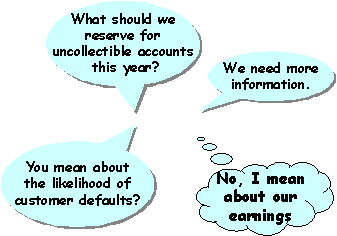Allowance for Uncollectible Accounts
Allowance for uncollectible (or doubtful) accounts is a charge to expense in the period that revenue is recorded based on the likelihood that some portion of receivables will not be collected despite the sales contract and bona fide efforts at collection.
Firms estimate this amount based on their historical relationship between the amount of bad debts and the amount of credit sales (percentage of sales) or the amount of unpaid customer balances (percentage of receivables). These estimates are used to adjust downward both sales and receivables.
This adjustment is made because the revenues of the period in which the sale is made would be overstated if a receivable went bad, not the revenues of the period in which the receivable were determined to be bad, which can be several accounting periods later.
Economics of Collection Uncertainty:
All receivables have some credit risk associated with them. That risk creates a probability that some receivables will go uncollected. The amount of bad debt, however, varies considerably from period to period, which make estimates for any particular period unreliable. Furthermore, the source of estimates for uncollectible amounts is generally not rigorous statistical analysis. Instead a considerable amount of subjectivity and bias is introduced into the adjustment to sales and receivables.
Behavioral Impact:
As a practical
matter, the allowance for uncollectible accounts acts as a reserve
account able to assist in the manipulation of accounting profits. Given
that management has discretion as to how much to allow for uncollectible
amounts, it is inevitable that management would consider the impact on
current period earnings.
In practice, management will benefit from a bias toward high estimates when profits are good, enabling the reserve account to store additional amounts "for a rainy day" and book low estimates when profits are lower, eating into the reserve account.
In this way, the bad debt reserve acts as any other reserve, capable of storing earnings when profits are up and boosting earnings when profits are otherwise down. It undermines the objectivity of the resulting Basic EP.
Alternative Treatment:
Charge only for uncollectibles:
Rather than assume that the uncollectible amount created an overstatement of past revenues, treat it as a failure to collect by not reserving for it and allowing the charge to affect income and net assets only when it is written off.
Companies typically have strict policies regarding collection that specify how accounts are to be aged and written off. This discipline creates an urgency about collections in contrast to the relative indifference toward credit risks one might have if they already been accounted for in a reserve.
With this more objective treatment of bad debt, managers will work harder to insure that each receivable does not go uncollected if each has the potential to create a specific charge.
The shortcoming of this approach is that future management may bear a cost bad credits approved by prior management. However, given the normal lag between the time revenue is booked and an account is written off being up to six months, this is not normally a serious drawback.